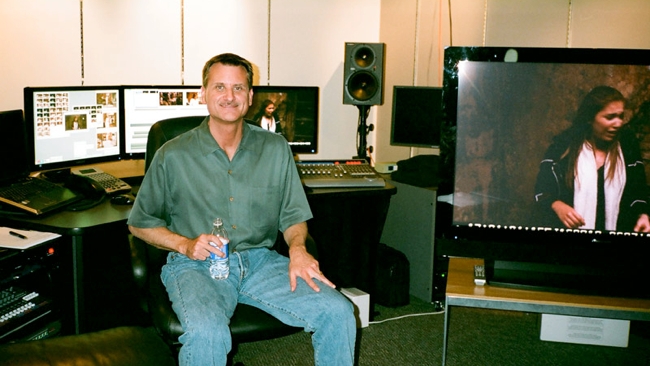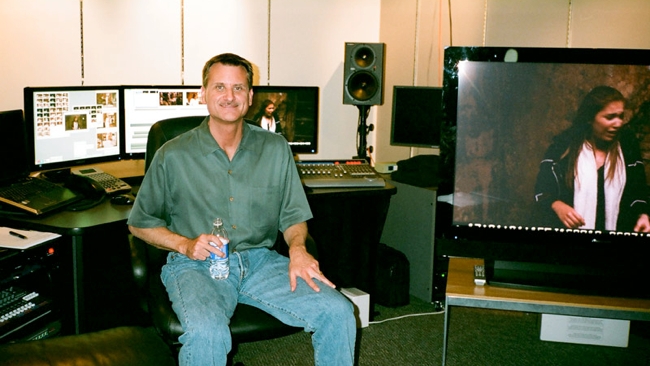
 Scott Hill
Scott Hill
As excitement mounts over the first showing of Lightworks for OS X, Editshare, Lightworks' parent company, has announced that Scott Hill, a long-time Hollywood editor and Lightworks user, will be giving a talk in the Theatre on the Editshare Booth (SL9010) at NAB
Feature film editor Scott Hill, whose well-known body of work includes Hollywood hits Zookeeper and Bruce Almighty, will discuss feature film editing and why the Lightworks move to Mac is a game changer.
He'll be on stage at 11:30 on Monday, Tuesday and Wednesday.
Last year, we spoke to Hill about Lightworks
How did you get started with editing? When did you know that you wanted to be an editor?
I played around making films in high school. I attended USC department of Cinema/TV.
What sort of equipment did you work with when you started editing?
We were working with 16mm film, cutting on Moviolas. I did some independent projects using 35mm as well.
What was your first experience of using an NLE?
I was working on the Law and Order TV series. We had a CMX 6000 Laserdisc editing system. Compared to the previous generations of technology, Laserdiscs were amazing: the pictures were pretty good and you could get as much as an hour per side. Lots of people came in to see this “science-fiction” device, but nowhere near as many as came in to see Lightworks when we got one! The shows were shot on film, telecine’d to ¾” tapes, which I digitized into Lightworks.
We got a Lightworks system because the editor I was assisting was a proponent of it, and it was a quick, natural progression from the Laserdiscs. We were really breaking new ground at Universal. I remember our hard drives were made of 3GB x 5 towers.
Amazingly, today, with the exception of digitising, the workflow from the editors point of view hasn’t changed at all - except that everything is so fast these days that we’re able to experiment much more.
What was the first film you used Lightworks on?
When I was working on Law and Order, we had the summers off, so I could work on other stuff. I was hired to train other editors on Lightworks, and through the contacts I made I was asked to work on “Walk in the Clouds” with Keanu Reeves. I also worked on the Nutty Professor, which was the start of my association with the comedy genre.
What is it about Lightworks that makes you choose it over other NLEs?
Lightworks is simply the tool I have found to be the most streamlined way to put a story together on film. It’s a great editor but all the essential tools are available for VFX as well. I never go to external software. Its capabilities in this area are more than people would imagine - you shouldn’t undersell Lightworks’ abilities as an all-round post-production tool!
While the technology might have changed over the years as we’ve moved from Film to File, the process is the same - and I can still cut faster on Lightworks than on any other tool. I’ve demonstrated this so many times to so many people - and they love it - especially when they see the console (Lightworks’ hardware control surface).
What would your typical workflow as an Editor be?
The first thing you do is to look at the footage to evaluate performances - always looking for little “gems”. You can often find things that the director’s been able to get out of the actors; often more than one thing. Watch all the footage. Find what grabs you or the actors - maybe a performance or a specific shot - and then build the scene around those nuggets.
On a technical level, all the clip management in Lighworks is extremely simple. When I have to work on other systems, my assistants beg me to go back to Lightworks!
And do you think Lightworks is as relevant now in the days of File-based workflows as it was with film?
It is. Absolutely!
Do you use Lightworks’ advanced features like Multi Camera?
I use it constantly: all the way since Nutty professor. Frequently there are shots with two or more cameras because you don’t get the chance to capture a unique performance again. We’d often have three cameras, and as many as six or seven in VFX or Action shots. On other industry-standard systems I’m very limited in how I can lock up multiple cameras. I can’t lock up sequences, for example - but on Lightworks I can. So I can work with several takes - just zipping through them. I can put all four cameras in Lightworks and just run through all the takes.
What do you think of the “democratization” of cinema through lower cost cinematic cameras, reusable media and free editing software?
It’s giving the world a greater opportunity to make films, which is terrific, but of course, it doesn’t make you a good storyteller! But it does open the door for genuinely talented people.
What’s your favourite film that you’ve worked on?
The next one! And of course there’s always a place in my heart for Bruce Almighty in 2003, and no one better than the director, Tom Shadyac, to work for.
How do you think we can bring Lightworks back to the forefront in high-end editing?
Studios have been forcing people to use other systems. The latest Lightworks software helps immensely - for example the fact that I can use DNxHD in Lightworks. All round, it’s back on par with the technology in Hollywood.
When I did Dance Flick on [Lightworks] Alacrity, we had no technical issues whatsoever. We exported EDLs, output lists to the Sound people: everyone was thrilled with how wonderful the process was - but the studios looked at me strangely because Alacrity only worked with AVIs. Now that we have DNxHD, we’re back in there!
How would you sum up Lightworks in non-technical terms?
Lightworks has always been an editing tool that happened to be a computer, and not a computer that’s an editor. There’s absolutely no technical barrier between the Editor and the film. You never have to worry about the technology getting in the way of the creative process.
Tags: Post & VFX


Comments